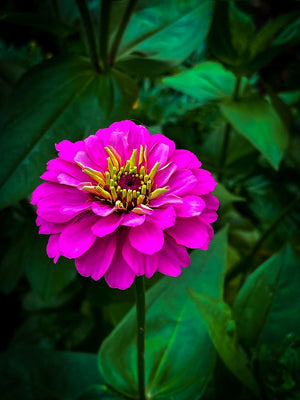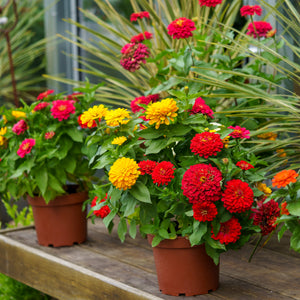The Zinnia Guide
Zinnias are beloved annuals known for their bold colors, extended bloom time, and ease of care. With their daisy-like blooms and upright form, zinnias make excellent additions to cutting gardens, cottage borders, and pollinator habitats. Ranging in size from compact dwarf varieties to tall, showy giants, zinnias offer something for nearly every landscape need. Their blooms appear in brilliant shades of red, pink, orange, yellow, white, and green, making them a favorite among gardeners looking to add vibrant color throughout the summer.

About
Zinnias belong to the Asteraceae family and are native to Mexico and Central America. The most commonly grown species is Zinnia elegans, which has been extensively hybridized to produce a wide variety of forms and colors.
- Zinnia 'Zahara Mix' offers disease-resistant, compact plants perfect for mass plantings or containers.
- Zinnia 'Benary Giants' are tall, long-stemmed varieties ideal for cut flower arrangements and garden focal points.
- Zinnia 'Queen Lime Mix' produces unusual chartreuse and pink-tinted flowers with vintage appeal.
- Zinnia 'Oklahoma Ivory' delivers creamy white blooms on strong stems for a soft contrast in vibrant gardens.
Zinnias are fast-growing, thrive in heat, and bloom from early summer until the first frost, making them a go-to choice for season-long color.

PLANTING
Planting zinnias is simple and rewarding, whether starting from seed or transplanting nursery starts:
- USDA Hardiness Zones: Grown as annuals in all zones. Replant yearly.
- Soil: Well-drained soil enriched with compost is ideal. Zinnias tolerate average to poor soils but dislike wet conditions.
- Sunlight: Full sun (at least 6 hours per day) is essential for maximum bloom production.
- Spacing: Space 8–24 inches apart depending on variety; tall types need more room and airflow.
- Planting Time: After the danger of frost has passed and soil has warmed. Seeds can be sown directly outdoors or started indoors 4–6 weeks earlier.
To sow, plant seeds ¼ inch deep and keep evenly moist until germination, which usually takes 5–7 days in warm soil. Thin seedlings as needed to reduce overcrowding and prevent disease.

CARE
Zinnias require little maintenance once established, but a few simple practices will maximize their health and flower output:
- Watering: Water regularly at the base of the plant to avoid wetting foliage. Let the top inch of soil dry out between waterings.
- Fertilizing: Apply a balanced, slow-release fertilizer at planting time. Avoid high-nitrogen fertilizers, which promote foliage at the expense of blooms.
- Deadheading: Remove spent blooms frequently to encourage continual flowering. Pinch young plants to encourage bushier growth.
- Pest & Disease Management: Powdery mildew can affect zinnias, especially in humid climates or crowded plantings. Provide good airflow and avoid overhead watering. Watch for aphids and spider mites.
Zinnias are highly resistant to heat and drought, making them excellent choices for hot, sunny gardens with minimal irrigation needs.

HOW TO USE
Zinnias are garden workhorses that excel in both practical and ornamental applications:
- Cut Flower Gardens: 'Benary Giants' and 'Oklahoma Ivory' are top picks for bouquets thanks to their long, sturdy stems and large blooms.
- Pollinator Gardens: Zinnias attract bees, butterflies, and hummingbirds. Combine with echinacea, rudbeckia, and monarda for maximum pollinator activity.
- Mass Plantings & Edging: Use compact varieties like 'Zahara Mix' in drifts along pathways or borders.
- Containers & Patio Planters: Dwarf types are easy to grow in pots, bringing bursts of color to decks, porches, and balconies.
- Cottage Gardens: Combine with cosmos, salvia, cleome, and ageratum for a whimsical, informal display.
Zinnias also pair beautifully with sun-loving perennials like yarrow, lavender, or coreopsis and provide a long-lasting contrast to foliage-heavy plants like ornamental grasses.

COMMON QUESTIONS
- Are zinnias perennials? Zinnias are annuals and complete their life cycle in one season. They do not return the following year.
- When to plant zinnia? Plant after the last frost in spring when soil has warmed. Direct sowing is simple and effective.
- Do zinnias come back every year? No, zinnias are not perennials and must be replanted each year.
- Do deer eat zinnias? Zinnias are generally deer resistant due to their coarse texture and strong scent.
- Are zinnias toxic to dogs? Zinnias are non-toxic to dogs and considered safe for pet-friendly gardens.
- Are zinnias toxic to cats? Zinnias are also non-toxic to cats.
- How to plant zinnia? Sow seeds directly outdoors in full sun and well-drained soil, spacing according to the mature size of the cultivar.
- Do rabbits eat zinnias? Zinnias are typically avoided by rabbits, though young seedlings may occasionally be nibbled.
- Do zinnias need full sun? Yes, zinnias require full sun for optimal blooming and disease resistance.
- When do zinnias bloom? Zinnias bloom from early summer through fall until the first frost.
Conclusion
Zinnias are among the easiest and most rewarding flowers to grow. With an abundance of colors, forms, and sizes, they provide unmatched seasonal interest, especially when other annuals begin to fade. Whether you're building a backyard cutting garden, attracting pollinators, or simply adding color to your containers, zinnias are a sunny-season staple that belongs in every gardener’s plan.
The Zinnia Collection
Sold Out
Sold Out
Sold Out
Sold Out
Sold Out



